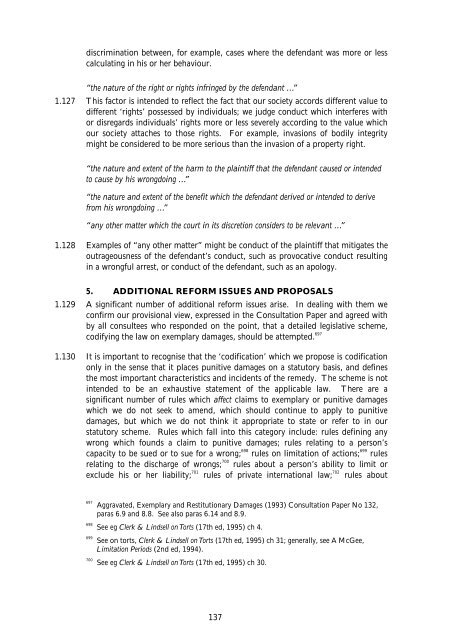Aggravated, Exemplary and Restitutionary ... - Law Commission
Aggravated, Exemplary and Restitutionary ... - Law Commission
Aggravated, Exemplary and Restitutionary ... - Law Commission
You also want an ePaper? Increase the reach of your titles
YUMPU automatically turns print PDFs into web optimized ePapers that Google loves.
discrimination between, for example, cases where the defendant was more or less<br />
calculating in his or her behaviour.<br />
“the nature of the right or rights infringed by the defendant ...”<br />
1.127 This factor is intended to reflect the fact that our society accords different value to<br />
different ‘rights’ possessed by individuals; we judge conduct which interferes with<br />
or disregards individuals’ rights more or less severely according to the value which<br />
our society attaches to those rights. For example, invasions of bodily integrity<br />
might be considered to be more serious than the invasion of a property right.<br />
“the nature <strong>and</strong> extent of the harm to the plaintiff that the defendant caused or intended<br />
to cause by his wrongdoing ...”<br />
“the nature <strong>and</strong> extent of the benefit which the defendant derived or intended to derive<br />
from his wrongdoing ...”<br />
“any other matter which the court in its discretion considers to be relevant ...”<br />
1.128 Examples of “any other matter” might be conduct of the plaintiff that mitigates the<br />
outrageousness of the defendant’s conduct, such as provocative conduct resulting<br />
in a wrongful arrest, or conduct of the defendant, such as an apology.<br />
5. ADDITIONAL REFORM ISSUES AND PROPOSALS<br />
1.129 A significant number of additional reform issues arise. In dealing with them we<br />
confirm our provisional view, expressed in the Consultation Paper <strong>and</strong> agreed with<br />
by all consultees who responded on the point, that a detailed legislative scheme,<br />
codifying the law on exemplary damages, should be attempted. 697<br />
1.130 It is important to recognise that the ‘codification’ which we propose is codification<br />
only in the sense that it places punitive damages on a statutory basis, <strong>and</strong> defines<br />
the most important characteristics <strong>and</strong> incidents of the remedy. The scheme is not<br />
intended to be an exhaustive statement of the applicable law. There are a<br />
significant number of rules which affect claims to exemplary or punitive damages<br />
which we do not seek to amend, which should continue to apply to punitive<br />
damages, but which we do not think it appropriate to state or refer to in our<br />
statutory scheme. Rules which fall into this category include: rules defining any<br />
wrong which founds a claim to punitive damages; rules relating to a person’s<br />
capacity to be sued or to sue for a wrong; 698<br />
rules on limitation of actions; 699<br />
rules<br />
relating to the discharge of wrongs; 700<br />
rules about a person’s ability to limit or<br />
exclude his or her liability; 701<br />
rules of private international law; 702<br />
rules about<br />
697 <strong>Aggravated</strong>, <strong>Exemplary</strong> <strong>and</strong> <strong>Restitutionary</strong> Damages (1993) Consultation Paper No 132,<br />
paras 6.9 <strong>and</strong> 8.8. See also paras 6.14 <strong>and</strong> 8.9.<br />
698 See eg Clerk & Lindsell on Torts (17th ed, 1995) ch 4.<br />
699 See on torts, Clerk & Lindsell on Torts (17th ed, 1995) ch 31; generally, see A McGee,<br />
Limitation Periods (2nd ed, 1994).<br />
700 See eg Clerk & Lindsell on Torts (17th ed, 1995) ch 30.<br />
137
















